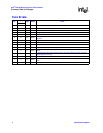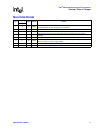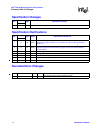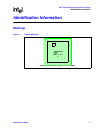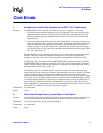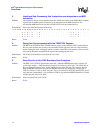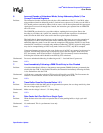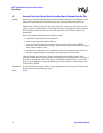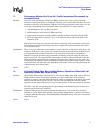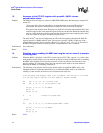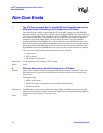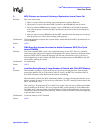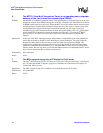
Specification Update 15
Intel
®
80219 General Purpose PCI Processor
Core Errata
6. Incorrect Decode of Unindexed Mode, Using Addressing Mode 5, Can
Corrupt Protected Registers
Problem: The instruction decoder incorrectly decodes the valid combination of P=0, U=1 and W=0, when
using unindexed mode in addressing mode 5 (load and store coprocessor). In this case, the LDC or
STC should produce consecutive address loads or stores, with no base update until the coprocessor
signals that it has received enough data. Instead, the instruction gets separated into an LDR/STR
and a CP access.
The LDR/STR gets decoded as a post-index address, updating the base register. Due to the
decoding as post-index, the ‘option’ bits, normally reserved for the coprocessor in unindexed
mode, become the 8-bit offset value used in the base register update calculation.
The implication is, that protected registers can be corrupted. This errata can cause the corruption of
FIQ registers, R13-R14, in user and system modes when the LDC instruction is executed using
unindexed addressing mode. It can also cause the corruption of FIQ registers, R8-R12, in any mode,
when the LDC instruction is executed using unindexed addressing. The R13 register in debug mode
may also be corrupted during an LDC in any mode. In the case of STC, only Rn is corrupted.
Unexpected memory accesses can also occur. In the case of an LDC, any memory location may be
accessed, since the FIQ registers may be improperly used as the base register. In the case of an
STC, the memory word located at Rn+4 is corrupted. This is the memory location immediately
following the locations which should be modified by STC unindexed.
Workaround: Do not use unindexed addressing in addressing mode 5 – Load and Store Coprocessor.
Status: NoFix.
7. Load Immediately Following a DMM Flush Entry is Also Flushed
Problem: A load that immediately follows a data memory management (DMM) flush entry command, that
also hits the data TLB, is also flushed. Therefore, the instruction immediately following the flush,
is also flushed from the data TLB.
Workaround: All flush entry commands to the data TLB must be followed by two NOPs. The first ensures the
erratum is not encountered, and the second ensures the speed path is not hit.
Status: NoFix.
8. Trace Buffer Does Not Operate Below 1.3 V
Problem: The trace buffer within the debug unit is not guaranteed to operate, due to voltage sensitivity, when
the core voltage supply is below 1.3 V.
Workaround: Make sure the voltage is above 1.3 V during debug.
Status: NoFix.
9. Data Cache Unit Can Stall for a Single Cycle
Problem: When the data cache unit retries an operation that is in the pending buffer, a single cycle stall
occurs.
Workaround: No workaround. This is a performance issue only.
Status: NoFix.




